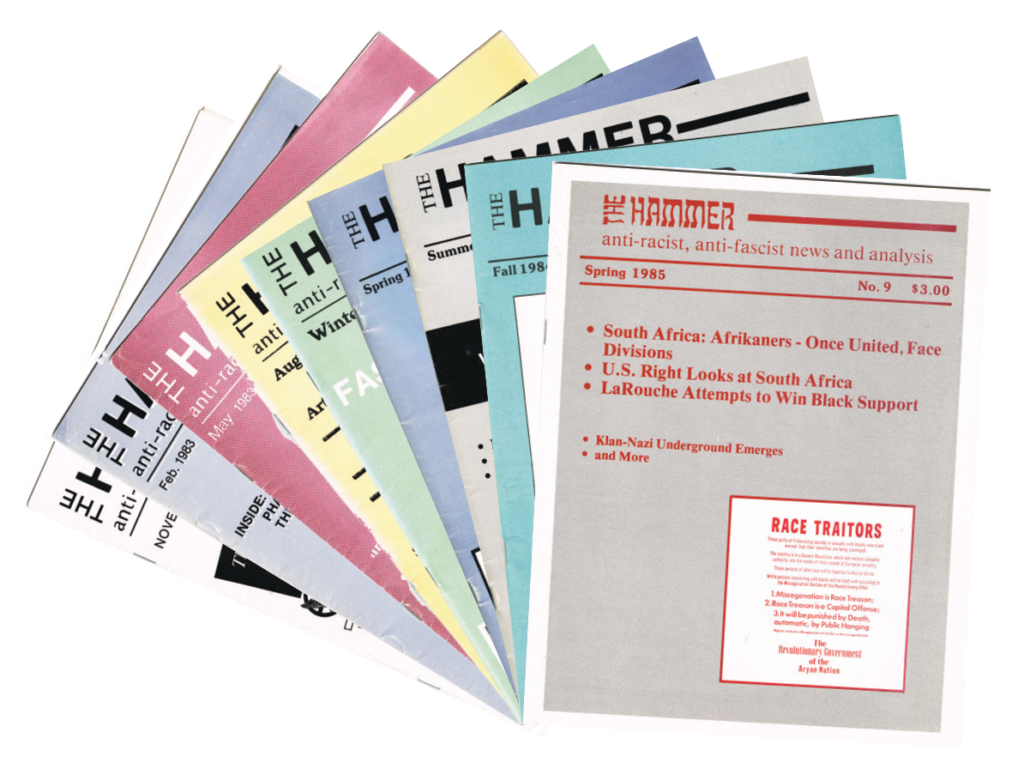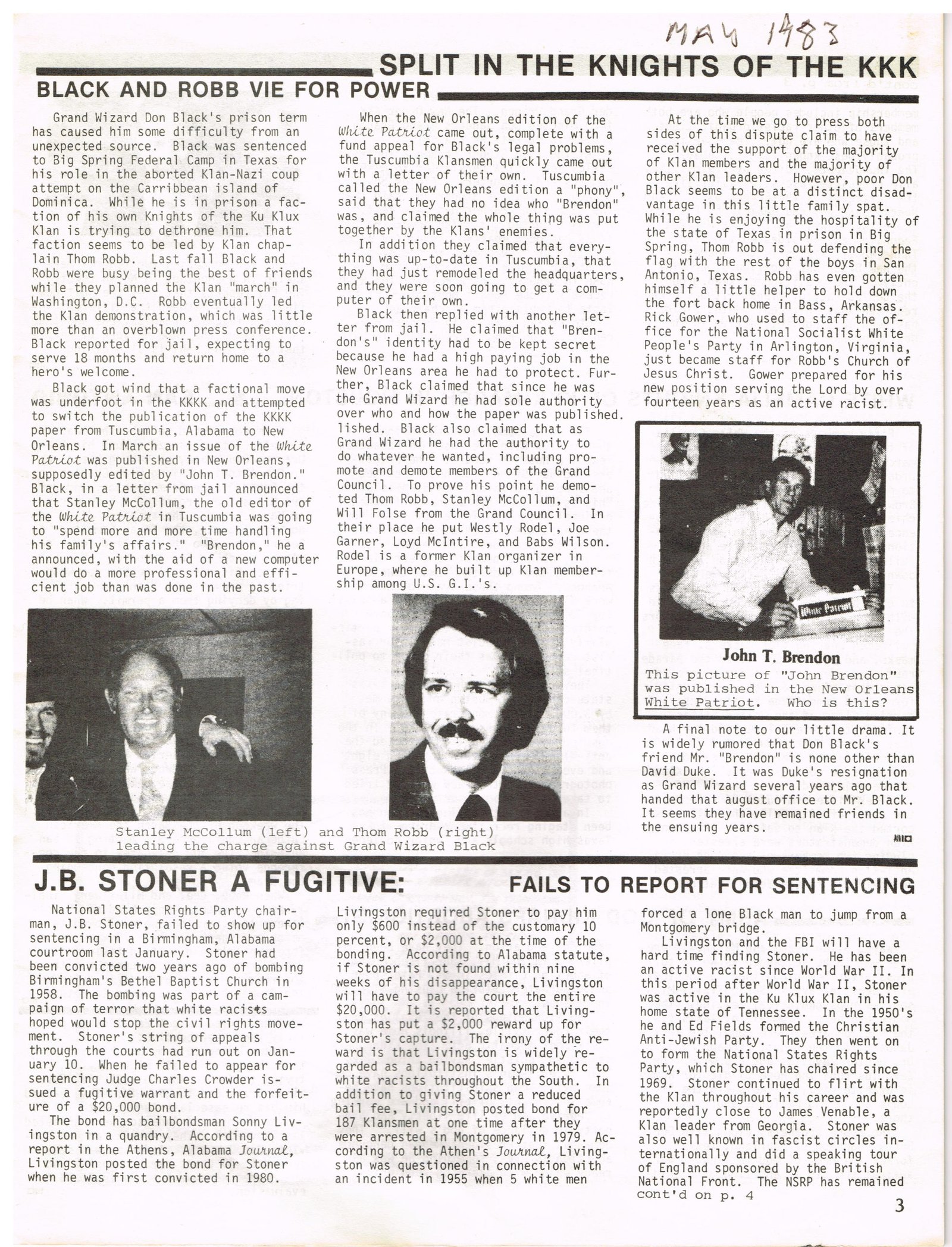Editor’s note: This year marks the fortieth anniversary of the founding of the Institute for Research and Education on Human Rights (IREHR). As part of our celebration of this milestone, each month we’ll look back at different chapters in the unique history of the organization, share personal stories, and dig deep into the archives. One of IREHR’s founders, Leonard Zeskind, gives us our first installment.- DB
Looking Back at 1983
By Leonard Zeskind
The Institute for Research & Education on Human Rights was founded forty years ago by a small group of people who saw danger on the near horizon and wanted everyone to prepare to meet it head-on. In all honesty, our small group of volunteers initially formed the organization to get a non-profit mailing permit for a periodical we published out of our own pockets, called The Hammer. At the time, we had no idea that IREHR would be around for four decades.
Across the country, white supremacists were organizing and growing. Racist, anti-Semitic, and bigoted violence blossomed hard. We had watched the white supremacist of the 1950s try and preserve Jim Crow. Then, five anti-Klan activists were murdered in Greensboro, North Carolina, in 1979. Now they wanted to destroy democracy and revolutionize society. And while a fight-back was being waged, a broader, deeper investigation of white supremacists was needed.
So, we did what we could.
Even before we officially became IREHR, we were conducting meaningful research. In 1982, we were researching paramilitarism in Missouri and Kansas when we uncovered a survivalist expo held at the Kansas City convention center. The Liberty Lobby, by then the largest anti-Semitic organization on the far right, had a booth. They distributed Spotlight tabloids, which had a subscription rate of about 300,000 at the time. The Covenant, Sword, and Arm of the Lord (CSA) also had a booth promoting a manual for its survivalist school down in the Ozarks. (The group was eventually shut down when the FBI rounded up members of The Order in 1985.) The media treated the expo as a trade show. We covered it in the first issue of our magazine for what it was: a white supremacist paramilitary recruiting exhibition.


The second issue, published in February 1983, had an article on a cult, The Way, and its international campus in Emporia, Kansas. In addition to the old-style far-right invective against Jews and Catholics, its libraries and classrooms carried Holocaust-denial books “for balance,” they said. Community members wanted to know the extent of the problem, so we found out.
We researched a split in the leadership of the Knights of the Ku Klux Klan. David Duke led this Klan group in the 1970s. It had grown quickly and had strong second-rank leadership. Duke quit the leadership top spot in 1980 and appointed his Alabama state leader, Don Black, to the post. But by 1983, Black was in prison for his plot to invade the island nation of Dominica. One leadership faction, including Thom Robb of Arkansas, was angling for more power. This was important news. So we covered it.
We also did stories in the magazine on Nazi war criminals receiving justice, incidents of bigotry-motivated violence, and the Christian Identity movement, which provided a theological justification for racism and anti-Semitism.
We were investigating, doing research, for facts that were beyond the naked eye. We knew that white supremacists felt no compunction about telling the truth. We knew that certain organizations had plans to kill Black people, Jews, Mexicans, Asians, gays and lesbians, and those of us who opposed them. But they did not talk about it on street corners. They complained about the lack of “white rights” but wanted “white power.” They had to be exposed.
That is what the Institute for Research and Education on Human Rights has been doing since Day One. To do that, we dug up data. Real facts. Not phony baloney.
In 1983, we incorporated, applied for, and received 501(c)3 non-profit status. With help from a special grant, we raised enough money to pay for mailing the magazine to over a thousand people and some newsstands in New York City and elsewhere.
 As our work spread through the magazine’s distribution, we began to hear from other groups and individuals looking to know more about growing white supremacist activity and how to respond. We realized we needed to adapt to these changes quickly.
As our work spread through the magazine’s distribution, we began to hear from other groups and individuals looking to know more about growing white supremacist activity and how to respond. We realized we needed to adapt to these changes quickly.
In our next installment exploring IREHR’s first forty years, we’ll look at how we rose to meet the challenge of the farm crisis and the advance of the Posse Comitatus.
Stay tuned.
We need your help to keep IREHR alive and thriving for years to come. Consider a tax-deductible contribution today.







